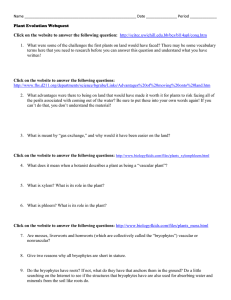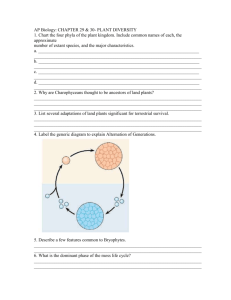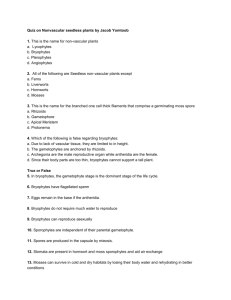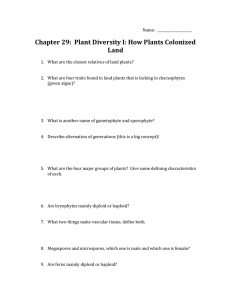–2 Bryophytes 22 Slide 1 of 33
advertisement
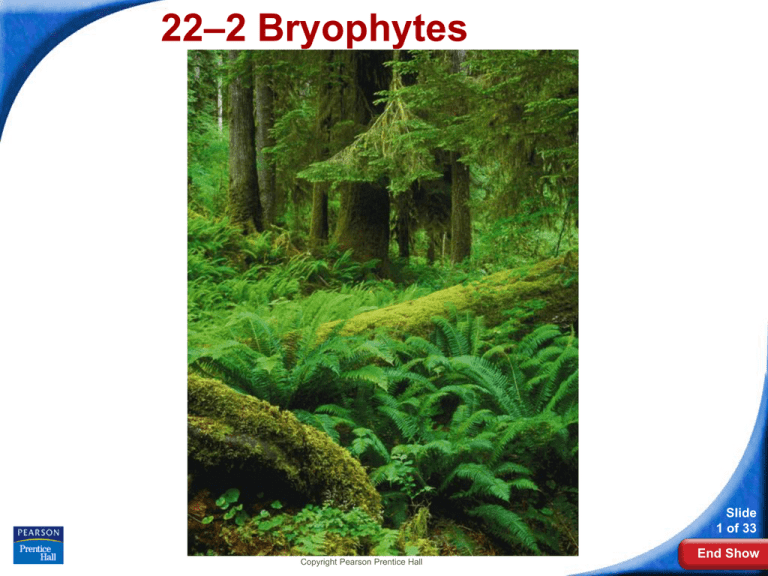
22–2 Bryophytes Slide 1 of 33 Copyright Pearson Prentice Hall End Show 22–2 Bryophytes Groups of Bryophytes Mosses and their relatives are called bryophytes, or nonvascular plants. They do not have vascular tissues, or specialized tissues that conduct water and nutrients. Bryophytes have life cycles that depend on water for reproduction. Bryophytes draw up water by osmosis only a few centimeters above the ground. Slide 2 of 33 Copyright Pearson Prentice Hall End Show 22–2 Bryophytes Groups of Bryophytes During one stage of their life cycle, bryophytes produce sperm that swim through water to reach eggs of other individuals. Therefore, bryophytes must live where there is rainfall or dew for part of the year. Slide 3 of 33 Copyright Pearson Prentice Hall End Show 22–2 Bryophytes Groups of Bryophytes Groups of Bryophytes Bryophytes are low-growing plants found in moist, shaded areas. The three groups of bryophytes are: •mosses •liverworts •hornworts Slide 4 of 33 Copyright Pearson Prentice Hall End Show 22–2 Bryophytes Groups of Bryophytes Mosses The most common bryophytes are mosses, members of the phylum Bryophyta. Mosses: • are adapted to life in wet habitats and nutrientpoor soils. • can tolerate low temperatures: most abundant plants in the polar regions. • are clumps of gametophytes growing together. Slide 5 of 33 Copyright Pearson Prentice Hall End Show 22–2 Bryophytes Groups of Bryophytes Capsule Each moss plant has a shoot that looks like a stem with leaves. Sporophyte Stalk These are not true stems or leaves, because they do not contain vascular tissue. Stemlike structure Gametophyte Leaflike structure Rhizoid Copyright Pearson Prentice Hall Slide 6 of 33 End Show 22–2 Bryophytes Groups of Bryophytes When mosses reproduce, they produce thin stalks, each containing a capsule. This is the sporophyte stage. The “leaves” of mosses are one cell thick, so they lose water quickly if the surrounding air is dry. Mosses have rhizoids, which are long cells that anchor them in the ground and absorb water and minerals from the soil, instead of true roots. Water moves from cell to cell through rhizoids and into the rest of the plant. Slide 7 of 33 Copyright Pearson Prentice Hall End Show 22–2 Bryophytes Groups of Bryophytes Liverworts Phylum Hepaticophyta Liverworts’ gametophytes form broad, thin structures that draw up moisture from the soil surface. Mature gametophytes produce structures that look like tiny green umbrellas. These carry the structures that produce eggs and sperm. Slide 8 of 33 Copyright Pearson Prentice Hall End Show 22–2 Bryophytes Groups of Bryophytes Some liverworts can reproduce asexually by means of gemmae. Gemmae are small multicellular reproductive structures. In some species, gemmae form in gemma cups. When washed out of the cup, the gemmae can divide by mitosis to produce a new individual. Slide 9 of 33 Copyright Pearson Prentice Hall End Show 22–2 Bryophytes Groups of Bryophytes Hornworts Phylum Anthocerophyta Found only in soil that is damp nearly year-round. Their gametophytes look like those of liverworts. The hornwort sporophyte looks like a tiny green horn. Slide 10 of 33 Copyright Pearson Prentice Hall End Show 22–2 Bryophytes Life Cycle of Bryophytes Life Cycle of Bryophytes Bryophytes reproduce and develop by alternation of generations. The gametophyte is the dominant, recognizable stage of the life cycle, and is the stage that carries out most of the plant's photosynthesis. The sporophyte is dependent on the gametophyte for supplying water and nutrients. Slide 11 of 33 Copyright Pearson Prentice Hall End Show 22–2 Bryophytes Life Cycle of Bryophytes Dependence on Water For fertilization to occur, sperm must swim to an egg. Bryophytes must live in habitats where water is available readily at least part of the year. Life Cycle of a Moss The life cycle of a moss illustrates how bryophytes reproduce and develop. Slide 12 of 33 Copyright Pearson Prentice Hall End Show 22–2 Bryophytes Life Cycle of Bryophytes When a spore lands in a moist place, it germinates and grows into a mass of tangled green filaments called a protonema. As the protonema grows, rhizoids grow into the ground and shoots grow into the air. These shoots grow into green moss plants, which are the gametophyte stage of its life cycle. Slide 13 of 33 Copyright Pearson Prentice Hall End Show 22–2 Bryophytes Life Cycle of Bryophytes Gametes form in structures at the tips of the gametophytes. Sperm with whiplike tails are produced in antheridia, the male reproductive structure. Eggs are produced in archegonia, the female reproductive structure. Some species produce both sperm and eggs on the same plant, while others produce them on separate plants. Slide 14 of 33 Copyright Pearson Prentice Hall End Show 22–2 Bryophytes Life Cycle of Bryophytes Protonema (young gametophyte) (N) Male gametophyte Female gametophyte Antheridia Sperm (N) Archegonia Sperm (N) Egg (N) Slide 15 of 33 Copyright Pearson Prentice Hall End Show 22–2 Bryophytes Life Cycle of Bryophytes Fertilization produces a diploid zygote. The zygote is the beginning of the sporophyte stage and grows directly from the gametophyte. It depends on the gametophyte for water and nutrients. The mature sporophyte is a long stalk ending in a capsule. Inside the capsule, haploid spores are produced by meiosis. When the capsule ripens, it opens and spores are scattered. Copyright Pearson Prentice Hall Slide 16 of 33 End Show 22–2 Bryophytes Life Cycle of Bryophytes Mature sporophyte (2N) Capsule (sporangium) Young sporophyte (2N) Gametophyte (N) Zygote (2N) Gametophyte (N) Slide 17 of 33 Copyright Pearson Prentice Hall End Show 22–2 Bryophytes Life Cycle of Bryophytes Life Cycle of a Bryophyte Mature sporophyte (2N) Gametophyte (N) Gametophyte (N) Slide 18 of 33 Copyright Pearson Prentice Hall End Show 22–2 Bryophytes Human Use of Mosses Human Use of Mosses Sphagnum mosses thrive in the acidic water of bogs. Dried sphagnum acts as a natural sponge. It can accumulate to form peat deposits. Peat can be cut from the ground and used as fuel. Peat can be used to improve the soil’s ability to retain water and to increase soil acidity. Slide 19 of 33 Copyright Pearson Prentice Hall End Show
